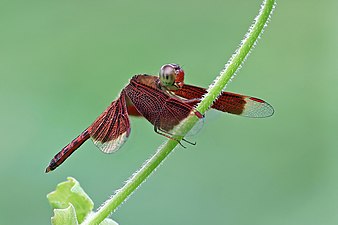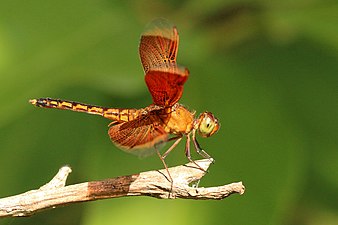
Odonata is an order of predatory flying insects that includes the dragonflies and damselflies. The two groups are distinguished with dragonflies usually being bulkier with large compound eyes together and wings spread up or out at rest, while damselflies are usually more slender with eyes placed apart and wings folded together along body at rest. Adult odonates can land and perch, but rarely walk.

A dragonfly is a flying insect belonging to the infraorder Anisoptera below the order Odonata. About 3,000 extant species of dragonflies are known. Most are tropical, with fewer species in temperate regions. Loss of wetland habitat threatens dragonfly populations around the world. Adult dragonflies are characterised by a pair of large, multifaceted, compound eyes, two pairs of strong, transparent wings, sometimes with coloured patches, and an elongated body. Many dragonflies have brilliant iridescent or metallic colours produced by structural coloration, making them conspicuous in flight. An adult dragonfly's compound eyes have nearly 24,000 ommatidia each.

Damselflies are flying insects of the suborder Zygoptera in the order Odonata. They are similar to dragonflies but are usually smaller and have slimmer bodies. Most species fold the wings along the body when at rest, unlike dragonflies which hold the wings flat and away from the body. Damselflies have existed since the Late Jurassic, and are found on every continent except Antarctica.

The red-veined darter or nomad is a dragonfly of the genus Sympetrum.
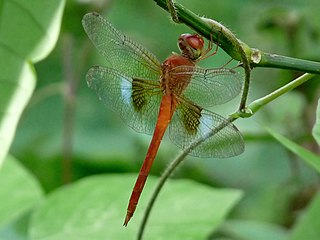
Tholymis tillarga, the coral-tailed cloudwing, is a species of dragonfly in the family Libellulidae. It is found from tropical West Africa to Asia, Australia and the Pacific Islands. Common names include old world twister, evening skimmer, crepuscular darter, foggy-winged twister and twister.

Tramea limbata is a species of dragonfly in the family Libellulidae. Its common names include black marsh trotter, ferruginous glider and voyaging glider.

Trithemis kirbyi, also known as the Kirby's dropwing,orange-winged dropwing, or scarlet rock glider is a species of dragonfly in the family Libellulidae.

Anax guttatus, the pale-spotted emperor or lesser green emperor, is a dragonfly of the family Aeshnidae.
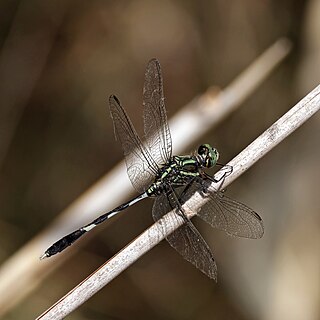
Orthetrum sabina, the slender skimmer or green marsh hawk, is a species of dragonfly in the family Libellulidae. It is widespread, being found from south-eastern Europe and North Africa to Japan and south to Australia and Micronesia.

Onychargia atrocyana a species damselfly in the family Platycnemididae. This species is commonly known as the marsh dancer or black marsh dart. It is found in Asia: Bangladesh, China, Hong Kong, Indonesia, India, Sri Lanka, Myanmar, Malaysia, Philippines, Peninsular Malaysia, Singapore, Thailand, Viet Nam.

Ceriagrion cerinorubellum, commonly known as the orange-tailed marsh dart or bi-coloured damsel, is a medium-sized damselfly in the family Coenagrionidae. It is a very common species of damselflies in Asia.

The blue riverdamsel, Pseudagrion microcephalum is a common species of damselfly in the family Coenagrionidae. It is also known as the blue sprite and blue grass dart.

Prodasineura verticalis is a damselfly in the family Platycnemididae. It is commonly known as the red-striped black bambootail or black bambootail.
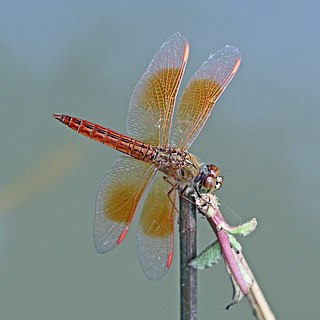
Brachythemis contaminata, ditch jewel, is a species of dragonfly in the family Libellulidae. It is found in many Asian countries.
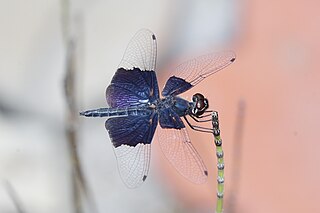
Rhyothemis triangularis is a species of dragonfly in the family Libellulidae. It is widespread in eastern and southern Asia.

Zyxomma petiolatum, known by the common names long-tailed duskdarter, brown dusk hawk and dingy duskflyer, is a species of dragonfly in the family Libellulidae. It is widespread in many Asian countries, New Guinea, northern Australia and islands in the Pacific.

Orthetrum testaceum, common names Crimson Dropwing or Orange Skimmer. is an Asian freshwater dragonfly species belonging to the family Libellulidae.

Brachydiplax chalybea is a species of dragonfly in the family Libellulidae. It is known by the common names yellow-patched lieutenant, rufous-backed marsh hawk, and blue dasher. It is native to much of eastern Asia, from India to Japan to Indonesia.

The giant hawker or the gigantic riverhawker, is a species of dragonfly in the family Aeshnidae. It is found throughout Sundaland, having been recorded on Thailand, Peninsular Malaysia, Singapore, Sumatra, and Borneo. It is the type species for the genus Tetracanthagyna.



